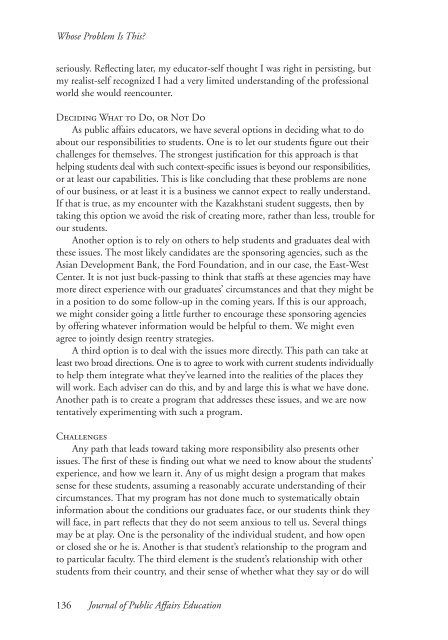Journal of Public Affairs Education
Create successful ePaper yourself
Turn your PDF publications into a flip-book with our unique Google optimized e-Paper software.
Whose Problem Is This?<br />
seriously. Reflecting later, my educator-self thought I was right in persisting, but<br />
my realist-self recognized I had a very limited understanding <strong>of</strong> the pr<strong>of</strong>essional<br />
world she would reencounter.<br />
Deciding What to Do, or Not Do<br />
As public affairs educators, we have several options in deciding what to do<br />
about our responsibilities to students. One is to let our students figure out their<br />
challenges for themselves. The strongest justification for this approach is that<br />
helping students deal with such context-specific issues is beyond our responsibilities,<br />
or at least our capabilities. This is like concluding that these problems are none<br />
<strong>of</strong> our business, or at least it is a business we cannot expect to really understand.<br />
If that is true, as my encounter with the Kazakhstani student suggests, then by<br />
taking this option we avoid the risk <strong>of</strong> creating more, rather than less, trouble for<br />
our students.<br />
Another option is to rely on others to help students and graduates deal with<br />
these issues. The most likely candidates are the sponsoring agencies, such as the<br />
Asian Development Bank, the Ford Foundation, and in our case, the East-West<br />
Center. It is not just buck-passing to think that staffs at these agencies may have<br />
more direct experience with our graduates’ circumstances and that they might be<br />
in a position to do some follow-up in the coming years. If this is our approach,<br />
we might consider going a little further to encourage these sponsoring agencies<br />
by <strong>of</strong>fering whatever information would be helpful to them. We might even<br />
agree to jointly design reentry strategies.<br />
A third option is to deal with the issues more directly. This path can take at<br />
least two broad directions. One is to agree to work with current students individually<br />
to help them integrate what they’ve learned into the realities <strong>of</strong> the places they<br />
will work. Each adviser can do this, and by and large this is what we have done.<br />
Another path is to create a program that addresses these issues, and we are now<br />
tentatively experimenting with such a program.<br />
Challenges<br />
Any path that leads toward taking more responsibility also presents other<br />
issues. The first <strong>of</strong> these is finding out what we need to know about the students’<br />
experience, and how we learn it. Any <strong>of</strong> us might design a program that makes<br />
sense for these students, assuming a reasonably accurate understanding <strong>of</strong> their<br />
circumstances. That my program has not done much to systematically obtain<br />
information about the conditions our graduates face, or our students think they<br />
will face, in part reflects that they do not seem anxious to tell us. Several things<br />
may be at play. One is the personality <strong>of</strong> the individual student, and how open<br />
or closed she or he is. Another is that student’s relationship to the program and<br />
to particular faculty. The third element is the student’s relationship with other<br />
students from their country, and their sense <strong>of</strong> whether what they say or do will<br />
136 <strong>Journal</strong> <strong>of</strong> <strong>Public</strong> <strong>Affairs</strong> <strong>Education</strong>



